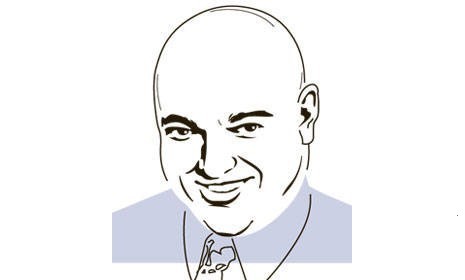The empty office presidency
Obama inexplicably embarks on a tour of Latin America as America launches military strikes in Libya


At the end of last year, a small-scale scandal erupted in New Jersey when a record-setting snowstorm hit the Garden State while both Gov. Chris Christie and Lt. Gov. Kim Guadagno vacationed outside the state. Christie had spent most of the year on the national stage using a confrontational style of leadership in showdowns with public unions, and to criticize the Obama administration, so this vacuum of executive leadership in a public crisis presented a unique opportunity to attack Christie — and many liberals did not allow it to pass.
Lately, we’ve been seeing plenty of examples of a lack of leadership from the White House that have nothing to do with freak weather conditions. Barack Obama has refused to engage directly in budget negotiations, a pose that has his own party’s Senate caucus wondering whether he’s setting them up to look radical by swooping in at the last moment to propose deeper cuts to the rump budget for fiscal year 2011. This week, the Obama administration made clear that it would not offer any leadership on Social Security reform until both parties release proposals of their own — despite then-candidate Obama’s insistence in October 2007 that he rejected the notion that Washington politicians “should hedge, dodge, and spin, but at all costs don’t answer” on Social Security policy.
We have seen a far more disturbing example of a presidential leadership vacuum this week in the unique presidential role as commander in chief. President Obama ordered the U.S. military to conduct acts of war against the nation of Libya, which had not initiated hostilities against our forces or directly threatened our national security. While some have criticized the advent of our military offensive as illegal in that it lacked congressional authorization, Obama’s actions have plenty of precedent in presidential military adventures over the last few decades. For instance, no congressional authorization preceded our attack on Libya in 1986, when Ronald Reagan ordered the bombing of intelligence targets in Libya’s capital after a terrorist attack in West Germany killed American soldiers.
The Week
Escape your echo chamber. Get the facts behind the news, plus analysis from multiple perspectives.

Sign up for The Week's Free Newsletters
From our morning news briefing to a weekly Good News Newsletter, get the best of The Week delivered directly to your inbox.
From our morning news briefing to a weekly Good News Newsletter, get the best of The Week delivered directly to your inbox.
While the U.S. Navy and Air Force conducted offensive operations in this new war, their commander in chief had gone on his public-relations tour of South America.
The issue at hand is not the substance of the military adventure, which can certainly be criticized for its timing and its purpose, but the manner in which the commander in chief has conducted himself during the opening of hostilities. When was the last time we saw an American president send forces into a new war — and then leave the country for an unrelated diplomatic tour as they engaged the enemy for the first time?
On Friday, March 18, Obama announced that U.S. forces would start engaging Libya's military under the aegis of U.N. Resolution 1973. Defense Secretary Robert Gates was tasked with coordinating with the defense ministers of our allies, and Secretary of State Hillary Clinton was sent to Europe to meet with their diplomats. Military action would be coming soon, to meet but not exceed the mandate from the U.N., Obama promised.
In fact, American forces engaged on this mission the very next day, with Operation Odyssey Dawn. But dawn on the 19th found Obama far from home. He and his family had boarded Air Force One the previous night and landed in Brazil at 6:35 a.m. While the U.S. Navy and Air Force conducted offensive operations in this new war, their commander in chief had gone on his public-relations tour of South America.
A free daily email with the biggest news stories of the day – and the best features from TheWeek.com
Obama had scheduled his tour of Latin America months earlier, but the same was true of his trip to Indonesia in 2010. That trip got postponed twice as domestic politics intruded on the president’s schedule. First, Obama pushed the date from March 2010 to June 2010 in order to push his health care reform bill to final passage. In June, he postponed the trip again, this time to take more control of the Gulf oil spill. It’s hard to argue that ObamaCare ranked as a higher priority than going to war, and yet Obama refused to delay his trip to Rio de Janeiro, where photo ops depicted him playing soccer in the street and watching children dance in the first two days of his war.
And where was the defense secretary at this time? The second in civilian command of the military left town on the 20th. Gates was scheduled to leave on the 19th, but he waited a day to “keep tabs” on the military action in Libya. Did he fly to consult with a member of the military coalition imposing the no-fly zone to coordinate efforts, as Obama announced two days earlier? Not exactly; Gates flew to Russia, which had to be talked out of vetoing U.N. Resolution 1973.
In an age of instant communications, presidents and defense secretaries can conduct their normal business while traveling, but war is not a normal business. A commander in chief needs to be in the same room as his military leaders at the onset of hostilities to make sure his strategies are properly deployed, to see the assessments of missions, and to track progress towards objectives.
At the very least, a president owes it to the American people to publicly exercise command and fortitude as he sends their sons and daughters into harm’s way for the first time. In fact, most presidents would welcome the opportunity to demonstrate their leadership. Instead, Obama demonstrated his samba moves and ability to juggle a soccer ball thousands of miles from where he belonged — and where the American people expected him to be.
Edward Morrissey has been writing about politics since 2003 in his blog, Captain's Quarters, and now writes for HotAir.com. His columns have appeared in the Washington Post, the New York Post, The New York Sun, the Washington Times, and other newspapers. Morrissey has a daily Internet talk show on politics and culture at Hot Air. Since 2004, Morrissey has had a weekend talk radio show in the Minneapolis/St. Paul area and often fills in as a guest on Salem Radio Network's nationally-syndicated shows. He lives in the Twin Cities area of Minnesota with his wife, son and daughter-in-law, and his two granddaughters. Morrissey's new book, GOING RED, will be published by Crown Forum on April 5, 2016.
-
 How climate change is affecting Christmas
How climate change is affecting ChristmasThe Explainer There may be a slim chance of future white Christmases
-
 The MAGA civil war takes center stage at the Turning Point USA conference
The MAGA civil war takes center stage at the Turning Point USA conferenceIN THE SPOTLIGHT ‘Americafest 2025’ was a who’s who of right-wing heavyweights eager to settle scores and lay claim to the future of MAGA
-
 The 8 best drama movies of 2025
The 8 best drama movies of 2025the week recommends Nuclear war, dictatorship and the summer of 2020 highlight the most important and memorable films of 2025
-
 Has Zohran Mamdani shown the Democrats how to win again?
Has Zohran Mamdani shown the Democrats how to win again?Today’s Big Question New York City mayoral election touted as victory for left-wing populists but moderate centrist wins elsewhere present more complex path for Democratic Party
-
 Millions turn out for anti-Trump ‘No Kings’ rallies
Millions turn out for anti-Trump ‘No Kings’ ralliesSpeed Read An estimated 7 million people participated, 2 million more than at the first ‘No Kings’ protest in June
-
 Ghislaine Maxwell: angling for a Trump pardon
Ghislaine Maxwell: angling for a Trump pardonTalking Point Convicted sex trafficker's testimony could shed new light on president's links to Jeffrey Epstein
-
 The last words and final moments of 40 presidents
The last words and final moments of 40 presidentsThe Explainer Some are eloquent quotes worthy of the holders of the highest office in the nation, and others... aren't
-
 The JFK files: the truth at last?
The JFK files: the truth at last?In The Spotlight More than 64,000 previously classified documents relating the 1963 assassination of John F. Kennedy have been released by the Trump administration
-
 'Seriously, not literally': how should the world take Donald Trump?
'Seriously, not literally': how should the world take Donald Trump?Today's big question White House rhetoric and reality look likely to become increasingly blurred
-
 Will Trump's 'madman' strategy pay off?
Will Trump's 'madman' strategy pay off?Today's Big Question Incoming US president likes to seem unpredictable but, this time round, world leaders could be wise to his playbook
-
 Democrats vs. Republicans: who are US billionaires backing?
Democrats vs. Republicans: who are US billionaires backing?The Explainer Younger tech titans join 'boys' club throwing money and support' behind President Trump, while older plutocrats quietly rebuke new administration
